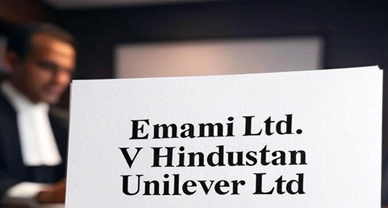Understanding the Scope of Distinctiveness of a Trademark Concerning Emami Ltd. V Hindustan Unilever Ltd.
The present matter[i] between Emami and Hindustan Unilever Ltd. (HUL) is a complex legal battle in the realm of “Intellectual Property Rights.” It delves into legal principles of ‘Trademark protection’, ‘Passing off’, and ‘Infringement’ of the Trademark with a special focus on the term “Handsome”. The present analysis examines whether a generic term can acquire distinctiveness and secondary meaning.
Factual circumstances
The case revolves around two major brands in men’s skincare products, Emami Ltd and Hindustan Unilever Ltd. (HUL). Emami has been dominant in the world of men’s fairness cream with their product “Fair and Handsome” since 2005. Over the years the petitioner has built a substantial market presence by achieving sales exceeding Rs. 2430 crores up to 2020 holding 65% share in the market and investing Rs. 400 Crores in marketing their product. The petitioner has consistently promoted its brand through numerous marketing campaigns., including initiatives like ‘MR. HANDSOME’, ‘HANDSOMENESS DAY’, etc. These campaigns demonstrate the petitioner’s sustained focus on the word “Handsome” in its branding strategy.
The conflict emerged when the respondent, HUL, a direct competitor and existing player in the fairness cream segment, began a rebranding process in 2018. This initiative was part of a broader global strategy by HUL’s parent company, Unilever PLC, to move away from terms like “fair,” “white,” and “light” in their product name. On June 25, 2020, Unilever announced this shift globally, emphasizing its commitment to promoting a more inclusive vision of beauty. The respondent launched “Glow and Handsome” in 2020, rebranding their existing product “MEN’S FAIR & LOVELY.”
The timing and sequence of events surrounding HUL’s rebranding raised significant concerns. The company had applied for nearly a dozen marks in 2018, but their sudden and hurried decision to adopt “Glow and Handsome,” despite an initial registration rejection, appeared questionable to the court. The case was brought to court immediately upon HUL’s launch of their rebranded product, with Emami seeking protection of their long-established brand identity.
Court’s reasoning
Trademark infringement
The petitioner alleges that the “Handsome” is a “prominent, leading, and essential feature of the petitioner’s mark that has also acquired distinctiveness and a secondary meaning.” Therefore, the use of this word by the respondents constitutes an infringement of the petitioner’s mark. Whereas the respondent contends that the word “Handsome” is purely descriptive, “It is a generic term also used by other competitors in the industry.” Even a disclaimer has been granted to the petitioner that, due to the prosecution history estoppel, the petitioner is not entitled to claim any right regarding the word “Handsome”.
In terms of whether the word “Handsome” has a secondary distinctive meaning depends upon the facts of the circumstances such as turnover, marketing expenditure, etc. As per the court’s reasoning, the petitioner has always used the word “Handsome” in a ‘generic’ sense due to which it cannot claim any monopoly over the trademark as held in the case of “Ultratech Cement Limited and Anr v. Dalmia Cement Bharat Limited”.[ii] The court observed, “The degree of distinctiveness, and, therefore, the possibility of registration as a trademark, is inversely proportional to the degree of obviousness: the more obvious the word, the less the degree of distinctiveness and the chances of its registration.” As per the court’s reasoning, the petitioner never marketed “Handsome” as a standalone mark. Also, while getting the mark registered, the petitioner’s stand that it would not assert any rights regarding the words “Fair” or ” Handsome” needs to be considered. Therefore, the court concluded that there is no scope for infringement in the present case.
The court pointed out the lack of bona fide behind the respondents’ adoption of the word “Handsome” as they cannot justify the reason behind suddenly adopting the impugned mark even when an application for registration of the same was rejected in 2018. The respondent was desperate to use the word “Handsome” even after bearing an obligation to not constitute infringement.
Passing off
The claim of passing off by the petitioner was made to refrain the respondent from falsely representing its goods to the public as that of the petitioner’s goods. In the case of Harrods v. Harrodian School Ltd[iii], the court stated the essential ingredients for passing off such as the trinity of reputation, misrepresentation, and damage to goodwill. Similarly, the court in the case of “Satyam Infoway Ltd. v. Siffynet Solution (P) Ltd.”[iv] held that the basis of a passing-off action is false representation. In the present matter, the court is not satisfied with the claim of infringement, however, an action of passing off can still succeed over it.
As per the court’s reasoning, mere confusion does not establish passing off but deception does. The respondent intentionally opted to choose a leading and prominent feature of the petitioner’s product. A purchaser of average intelligence can be easily misled by the word “Handsome” which could hamper the long-built goodwill of the petitioner. The respondents cannot be allowed to take a free ride over someone else’s rights. Therefore, the claim of the petitioner for passing off is accepted by the court.
Critical analysis
When a company uses descriptive words, it takes many years, not just a short time, to make those words uniquely associated with their brand. Companies often pick descriptive terms to advertise their products. They then use these same words repeatedly in their marketing for a significant time. Eventually, customers connect these descriptive words specifically with that company’s brand.
It is evident from the facts of the case that Emami has established itself for the past 20 years and has spent almost 400 Crores on marketing its product. Whereas, the respondents started the rebranding of their product in 2018. The court failed to give due consideration to this fact and hence, the claim of infringement by the petitioners was rejected. In the case of “Marico Ltd. v Agro Tech Foods”,[v] the apex court observed, “Distinctive has been explained to mean such use of the trademark with respect to the goods of a person that the public will immediately and unmistakable co-relate the mark with the source or a particular manufacturer.” Considering this observation, the term “Handsome” that has been used by the petitioner since 2005, the general public may without giving much attention to the name of the brand, just by looking at the term “Handsome” in a fairness cream, assume it to be of the petitioner’s brand and may mistakenly purchase the one of the respondent’s. This proves the respondent’s mala fide intention behind adopting such a mark to deceive the general public. The court also pointed out, referring to the case of “Heinz Italia and Another v. Dabur India Ltd.”[vi] that, “courts should ordinarily lean against holding distinctiveness of a descriptive trademark unless the user of such trademark is over such a long period of time of many many years that even a descriptive word mark is unmistakably and only and only relatable to one and only source i.e. the same has acquired a secondary meaning.” The term “long period of time” or “many many years” has not been defined anywhere, but considering it to be a reasonably long period, 20 years’ worth of marketing by the petitioner and 4-5 years by the respondent, the petitioner demonstrates a substantial position.
The petitioner is a continuous user of the mark “Handsome” and has a significant sales figure of Rs. 2430 crores. This established market presence and considerable commercial success clearly indicate the petitioner’s acquired goodwill. The court’s failure to acknowledge these material facts in its deliberation suggests an arbitrary approach to judicial reasoning. In the case of “Laxmikant V. Patel v. Chetanbhat Shah and Anr.”[vii] the SC states that “by virtue of the trademark’s prior, continuous and comprehensive use, the word combination has acquired distinctiveness and is therefore protected.” Similarly, the Intellectual Property Appellate Board, in the case of “M/A P.K. Overseas Pvt. Ltd. v. M/S KRBL Ltd.”[viii], observed that the continuous use of a trademark combined with strong sales performance could serve as evidence to prove that a mark has acquired distinctiveness and built up goodwill in the marketplace. Specifically, the continuous usage and significant sales data for “Bemisal” helped establish it as a valid trademark by showing it had developed a distinctive character and reputation among consumers.
To sum up, ‘Handsome’ has acquired a distinctive meaning through extensive use and application in the market. At the receiver’s end, the public recognizes Emami Pvt. Ltd. with the mark, providing an identity that is definitive of market practicality rather than mere technicality. This brand synonymy has been achieved through the due course of time, a huge monetary investment, and the persistence of the brand.
All of this is a widely accepted fact, but the bone of contention is that once the nature of the mark has been transformed to the tier of distinctiveness, the protection of the mark must be ensured by law, specifically Section 2(1)(zb) of the Trade Marks Act, 1999 which provides the statutory definition of a trademark, mentioning the inclusivity of distinctive marks under the same and Section 9(2) which provides the crucial exception of ‘acquired distinctiveness’. This factor has been overlooked by the Hon’ble Court, by rejecting the infringement rights on the basis of not being sufficiently proved to have acquired distinctiveness, but on the other hand, if we apply the statistics to the ‘Test’[ix] as provided by the same court to identify distinctiveness, we can see the divergence of facts and the understanding of the court. To an extent, the fairness of the judgment is in question as it is a legal tenet to protect the rights of the brand with respect to their identity and the earned consumers of the market, which seems to be left vulnerably in this case.
Author:– Khushi Vashisth, in case of any queries please contact/write back to us at support@ipandlegalfilings.com or IP & Legal Filing.
[i] Emami Limited vs Hindustan Unilever Limited on 9 April, 2024
[ii] Ultratech Cement Limited And 1 Ors vs Dalmia Cement Bharat Limited on 10 June, 2016
[iii] Harrods v Harrodian School Ltd [1996] RPC 697, 713.
[iv] Satyam Infoway Ltd vs Siffynet Solutions Pvt. Ltd on 6 May, 2004
[v] Marico Limited vs Agro Tech Foods Limited on 1 November, 2010
[vi] M/S.Heinz Italia & Anr vs M/S.Dabur India Ltd on 18 May, 2007
[vii] Laxmikant V.Patel vs Chetanbhat Shah & Anr on 4 December, 2001
[viii] M/A P.K. Overseas Pvt Ltd v M/S KRBL Ltd [2014] 57 PTC 129 (IPAB).
[ix] J Thomas McCarthy, McCarthy on Trademarks and Unfair Competition, vol 2 (Thomson West 2003).



